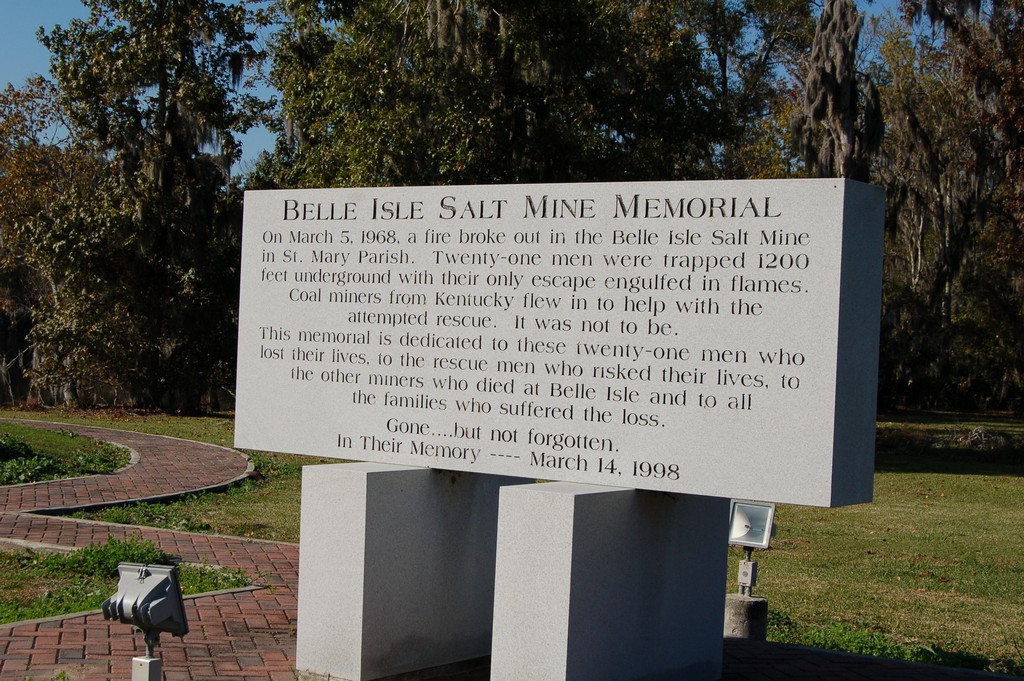
The catastrophe at Belle Isle continues to trouble former employees and family members of the 21 victims who perished 1,250 feet below the salt mine. The disaster occurred shortly before midnight on March 5, 1968, when a huge fire began inside the mine and subsequently killed the miners. It was Louisiana’s worst salt mine disaster. Cargill, the owner of the mine, had no rescue teams, so experienced rescuers from Kentucky were called in.
Although a complete federal safety inspection of Belle Isle had never been made before the incident, it had been visited several times by Bureau of Mines representatives at the request of Cargill. Inspections were made on between 1963 and 1967. The most recent was on August 9, 1967, nearly seven months before the catastrophe. After the last inspection, it was suggested that Cargill opened another shaft to be used as an emergency exit. According to reports when the accident occurred, Cargill planned to sink a second shaft about 900 feet from the only existing shaft entrance at Belle Isle.
At the time of the Belle Isle tragedy, there was a total workforce of 60 employees, of which 32 were classified as regular underground employees. Some of these employees actually worked underground intermittently, including staff officials who spent some time below. The mine had a single shaft with an inside diameter of 16 feet. The mine was operating at 1,250 feet below the surface, producing an average of 6,400 tons of salt daily.
Meanwhile, the day after the salt mine tragedy, two teams of rescuers consisting of 14 volunteers boarded a chartered flight from Madisonville, Ky. The DC3 landed at Patterson air field with the nation’s top mine rescuers. They were quickly flown by helicopter and arrived at Belle Isle near midnight, 24 hours after the fire inside the salt dome.
Ed Holeman of Sullivan, Ky., and Dilford Holmes of Madisonville, Ky., were the first rescuers to volunteer to go down the salt mine. Equipped with gas masks, they were lowered in a makeshift bucket fashioned from a discarded fan casing. The rescuers were armed with a bullhorn but were forbidden to leave the bucket. They called out to the trapped miners; however, there was no response. It took seven trips down the mine shaft over a three-day period enduring 95 degree temperatures heavily laden with carbon monoxide before all 21 victims were located. It took an additional two dozen more trips down the shaft over several more days before their bodies were finally taken topside. The date was March 12, 1968, exactly one week after the ordeal began.
The victims were brought up in the makeshift bucket three at a time. According to the St. Mary Parish Coroner, Dr. G.P. Musso Jr., 20 of the miners died from carbon monoxide poisoning and one from head trauma — probably from falling debris. F. Clayton Tonnemaker, former Green Bay Packer football great and Cargill VP, had the unfortunate task of informing the victim’s families of the fate of their family members. “It was pandemonium, family members were sobbing and screaming uncontrollably,” said Russell Landry of Kaplan, who had been a 20-year-old maintenance electrician at the mine. Landry had quit his job two weeks prior to the mine disaster. Safety was Landry’s main reason for leaving, and it was his crew that perished that day in 1968.
The oldest victim of the tragedy was 50, the youngest was 20. Three of the victims were brothers-in-law; they had married three sisters — all from Abbeville. Six of the victims had five years’ experience, several had been employed three to four years; a few had been there for several months. One of the victims had been working for eight days, while another had been employed for only four days. Neither of the two new hires had drawn their first paycheck.
Although evidence was examined during a six-month investigation, neither the cause of fire nor the point of origin could be definitely established. According to a final report, it appears that the fire originated in the lower part of the shaft at about, or below, the mining level.
Special thanks go to Debbie (Holeman) Guess, who was instrumental in obtaining the needed funds for the creation of a bronze memorial statue honoring all of the fallen salt miners,and to art teachers, Jenny Authement and Mike Howes from Nicholls State University for their larger-than-life size sculpture of a salt miner, which is on display at the Franklin visitor center. Thanks also go to Russell Landry of Kaplan and Allen LeBlanc of Abbeville for their contribution to the Belle Isle articles and to Arthur Olivier from Grand Mary, who was selected as the model for the sculptors to design and create the memorial statue. Olivier was not only employed at Belle Isle, he lost a son and two nephews in the ill-fated mine.
Sunday 19 May 2013
http://www.theadvertiser.com/article/20130519/LIFESTYLE/305190008?nclick_check=1
continue reading







